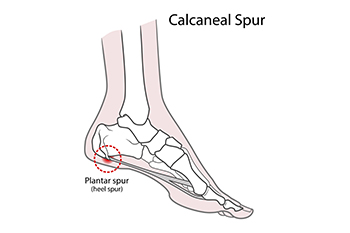
A calcium build-up on the underside of the heel may indicate a heel spur has developed. It can happen by increasing speed and distance too quickly while running or by wearing shoes with inadequate support. Additionally, medical conditions such as rheumatoid arthritis may cause a heel spur to develop. Regardless of the cause, a heel spur can be painful, and walking can become difficult. A diagnosis is often performed, which consists of having an X-ray taken. This is successful in ruling out a fractured heel bone. The symptoms associated with a heel spur can include sharp pain under the foot, which may become worse after a prolonged time of rest, and the affected foot may feel warm when touched. Treatment can begin with elevating the foot and temporarily stopping the activity that may have caused the heel spur. Performing specific stretches may help to alleviate some of the discomfort, as well as to maintain a healthy weight. If you have heel pain, it is strongly suggested that you speak to a podiatrist as soon as possible who can effectively diagnose and treat heel spurs.
Heel spurs can be incredibly painful and sometimes may make you unable to participate in physical activities. To get medical care for your heel spurs, contact Priyanka Mude, DPM from North Canton Podiatry. Our doctor will do everything possible to treat your condition.
Heels Spurs
Heel spurs are formed by calcium deposits on the back of the foot where the heel is. This can also be caused by small fragments of bone breaking off one section of the foot, attaching onto the back of the foot. Heel spurs can also be bone growth on the back of the foot and may grow in the direction of the arch of the foot.
Older individuals usually suffer from heel spurs and pain sometimes intensifies with age. One of the main condition's spurs are related to is plantar fasciitis.
Pain
The pain associated with spurs is often because of weight placed on the feet. When someone is walking, their entire weight is concentrated on the feet. Bone spurs then have the tendency to affect other bones and tissues around the foot. As the pain continues, the feet will become tender and sensitive over time.
Treatments
There are many ways to treat heel spurs. If one is suffering from heel spurs in conjunction with pain, there are several methods for healing. Medication, surgery, and herbal care are some options.
If you have any questions feel free to contact our office located in North Canton, Ohio . We offer the latest in diagnostic and treatment technology to meet your needs.
